Paying Attention to Your Balance Arm
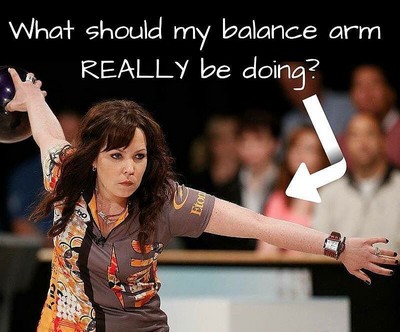 As you swing a weighted ball on one side of your body, you are prone to imbalance, and maintaining a straight ballswing is much more difficult. Other forces must counteract that imbalance if you are to maintain a consistent and predictable ball swing. Moreover, you must accomplish this with the body in motion. Your arms and legs automatically function in a smooth, coordinated movement in order to create an ideal ball swing. Let’s talk about the importance of the balance arm (the arm opposite of the ball) as a dynamic entity that assists in maintaining good body balance during the swing.
As you swing a weighted ball on one side of your body, you are prone to imbalance, and maintaining a straight ballswing is much more difficult. Other forces must counteract that imbalance if you are to maintain a consistent and predictable ball swing. Moreover, you must accomplish this with the body in motion. Your arms and legs automatically function in a smooth, coordinated movement in order to create an ideal ball swing. Let’s talk about the importance of the balance arm (the arm opposite of the ball) as a dynamic entity that assists in maintaining good body balance during the swing.
Great balance is essential to great shot making. But how do we achieve great balance? Some of this comes from the balance arm. Most bowlers have given the balance arm little serious thought during their approach. In the minds of many bowlers the opposite arm does little, and is just there to make sure they don’t fall over when they release the ball. In reality, by being a bit more mindful of what you do with your balance arm, adjusting how you use your balance arm can improve your balance, improve the energy transfer from the hand to the ball, and elevate your physical game. Most elite bowlers in the world focus heavily on their balance arm.
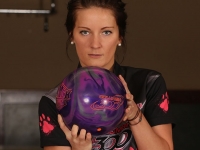 As a bowler begins their push-away, both hands move forward with the initial ball motion. As the ball is released from the non-ball hand (the balance hand), it moves downward into the swing, and the balance arm continues to point forward than relaxing to the side just as it would as you normally walk and swing your arms. And, just as you would normally walk, one arm naturally goes forward as the other arm goes back. As the ball moves downward into the swing and the ball-side arm starts to swing back, the opposite arm (the balance arm) moves forward, and as the ball begins to move forward, the balance arm moves backward to maintain good body balance.
As a bowler begins their push-away, both hands move forward with the initial ball motion. As the ball is released from the non-ball hand (the balance hand), it moves downward into the swing, and the balance arm continues to point forward than relaxing to the side just as it would as you normally walk and swing your arms. And, just as you would normally walk, one arm naturally goes forward as the other arm goes back. As the ball moves downward into the swing and the ball-side arm starts to swing back, the opposite arm (the balance arm) moves forward, and as the ball begins to move forward, the balance arm moves backward to maintain good body balance.
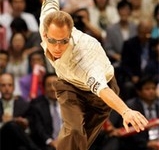 Fundamentally, the balance hand is pointed forward and low (ideally at about waist height) and slightly outward until the ball reaches the top of the backswing. Once the ball reaches the top of the backswing, the arms begin their motion in the opposite direction.
Fundamentally, the balance hand is pointed forward and low (ideally at about waist height) and slightly outward until the ball reaches the top of the backswing. Once the ball reaches the top of the backswing, the arms begin their motion in the opposite direction. 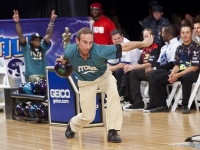 The ball-side arm moves forward and the balance arm moves back just as though you were walking to the store, only more pronounced since the bowler has a heavy ball in one hand. So, what does this motion accomplish?
The ball-side arm moves forward and the balance arm moves back just as though you were walking to the store, only more pronounced since the bowler has a heavy ball in one hand. So, what does this motion accomplish?
First, it is easier to move your shoulders if you move the balance hand forward as your ball-side hand moves back.
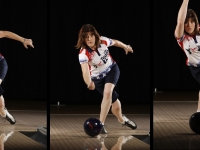 Second, this motion creates an arm swing-slot where the ball travels directly under your head and shoulder during the swing.
Second, this motion creates an arm swing-slot where the ball travels directly under your head and shoulder during the swing.
Third, this motion allows your trunk to turn slightly, which creates a torque and power that you can turn into leverage and revolutions at the bottom of the swing.
Why are power players more accurate than others? If you watch these players in slow motion, you will see the balance arm forward, the trunk turn slightly in the backswing, and then return to a shoulder-square release point, albeit with the bowling shoulder lower than the balance arm shoulder and their ball swing directly under their head.
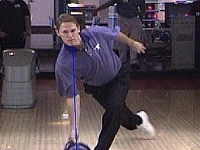 Elite bowlers can consistently hit a target line because the swing stays under the head and goes in a straight line. So, to create a good arm slot, move the balance arm forward as the ball-side arm moves back toward the top of the backswing.
Elite bowlers can consistently hit a target line because the swing stays under the head and goes in a straight line. So, to create a good arm slot, move the balance arm forward as the ball-side arm moves back toward the top of the backswing.
It is important to keep the balance hand thumb pointing down, as this will prevent you from moving the arm back past your shoulders in the downswing. If you are still not sure of this, try this simple test. First, stand up and stick your balance arm out with your thumb pointed up. Now, move your arm back as far as you can. Next, do the same thing with your thumb pointed down. You will find that as your hand gets to be even with your shoulders, you will feel resistance – the bio mechanical effect of how our bodies are constructed. Let’s take a look at some of the professional bowlers. You can also see roughly the same positioning of the balance hand with the balance hand thumb down and the balance arm slightly out and swinging back to maintain consistent body balance and shoulder rotation control. Finally, note that with these bowlers still maintain balance by keeping the lower body underneath their shoulders. Balance comes from the proper use of the balance arm AND keeping the lower body beneath you to create great balance.
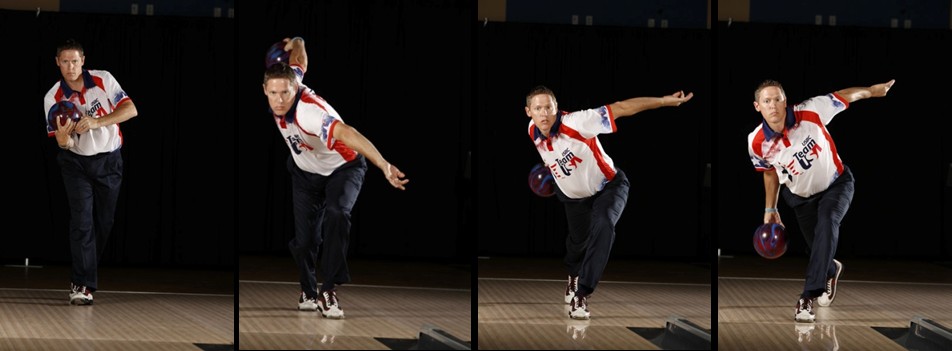
Let’s be Real
Up to this point, this discussion addresses the non-ball-side arm as the balance arm. While this is certainly a worthy point, with regard to functionality, the non-ball-side arm does more than assist with a bowler’s balance.
The motion and timing of the non-ball-side arm determines the position of the shoulders at the point of release. As the ballswing and the balance arm is a dynamic in your approach, the movement of the ball and arms torque the body torso. The body torso rotation is largely controlled by both the ball swing and the the balance arm as the bowler’s approach moves from stance to the point of release. In any sport involving body movement, both arms and their relational position to one another as well as their affect on the body torso form a dynamic system that greatly affects the success of the participant.
As an illustration, standing upright with your arms at your side, as the non-ball-side arm is moved forward, the ball-side shoulder will move backward, and your head will turn toward the channel. As the ball-side shoulder moves forward, your head will normally move toward the center of the lane. This illustrates what happens when the movement of either arm over-rotates. This is one of the primary causes of inconsistency when over-rotation of either arm causes the bowlers head to erroneously move away from the target. However, when you develop a healthy respect for your balance arm as a tool to establish control of the body torso and head rotation, you will reduce the possibility of injury of your neck and shoulder. This will allow you more efficient energy transfer from the arm to the ball as it leaves your hand. This is true whether you analyze a baseball pitcher, football passer, golfer, or a bowler.
If you want to improve your bowling, have a certified coach analyze the use of your balance arm and the position of your balance arm at the point of release.
Athletes often have limitations to their range of motion and they can be caused by any number of reasons. If someone’s had a prior shoulder injury, a limitation due to size or muscular imbalance or even an overall physical balance issue, the body may not be able to incorporate the balance arm (opposite arm) thumb down approach.
Without a being able to see your game it’s impossible to pin point why you may not be able to do this so have a certified coach evaluate your game and see if adjustments can be made in this area for improvement. If there are physical or health limitations seek a medical professional for assistance.
Team USA Head Coach Rod Ross and professional bowler Chris Barnes demonstrate why it is important to focus on keeping your non-ball side shoulder forward during your approach. You can accomplish this by turning your palm down when you follow through to counter balance the motion of your swing arm. Accurate, consistent bowling begins with keeping your shoulders aligned every time.